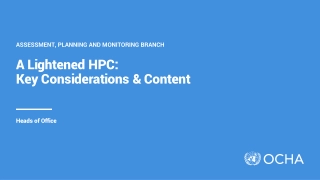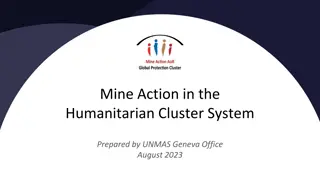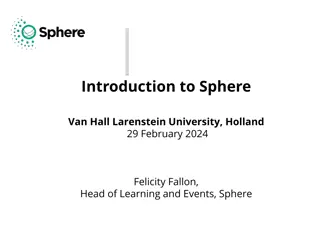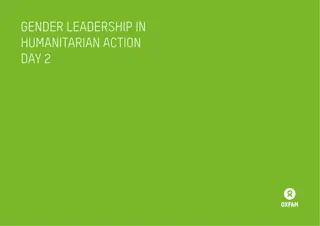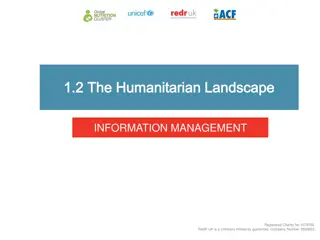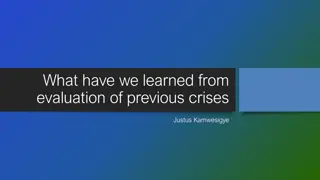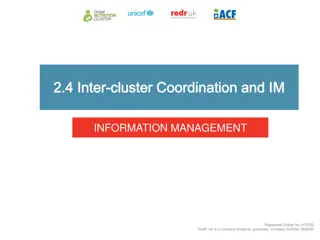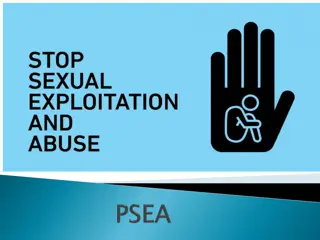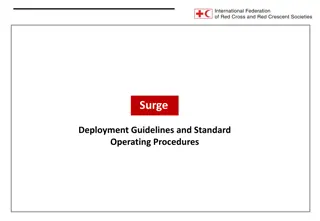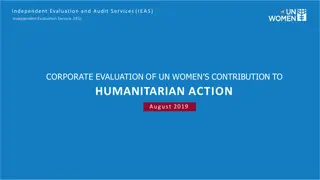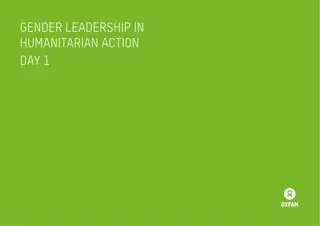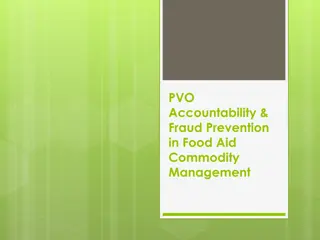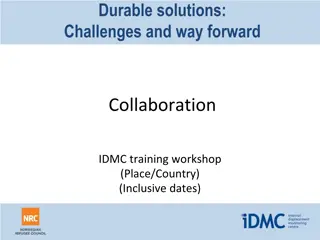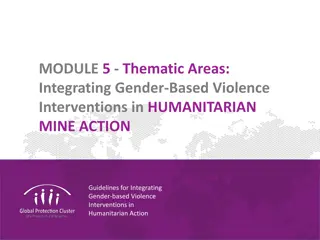
Core Humanitarian Standard: Quality and Accountability in Assistance
Nine commitments aim to enhance the quality and effectiveness of humanitarian aid, ensuring appropriate assistance, preparedness, rights awareness, complaint handling, and more. Additionally, Oxfam's 16 Minimum Standards for Gender in Emergencies promote gender equality through various practices. Gender analysis in humanitarian programs helps identify specific needs, root causes of vulnerabilities, and design interventions addressing inequalities.
Uploaded on | 0 Views
Download Presentation

Please find below an Image/Link to download the presentation.
The content on the website is provided AS IS for your information and personal use only. It may not be sold, licensed, or shared on other websites without obtaining consent from the author. If you encounter any issues during the download, it is possible that the publisher has removed the file from their server.
You are allowed to download the files provided on this website for personal or commercial use, subject to the condition that they are used lawfully. All files are the property of their respective owners.
The content on the website is provided AS IS for your information and personal use only. It may not be sold, licensed, or shared on other websites without obtaining consent from the author.
E N D
Presentation Transcript
Slide 1 Core Humanitarian Standard on Quality andAccountability Nine commitments to improve quality and effectiveness of humanitarian assistance. Each commitment has quality criteria, key actions and organizational responsibilities. Source: www.corehumanitarianstandard.org
Slide 2 Core Humanitarian Standard on Quality and Accountability The commitments set out that communities and people affected by crisis: Commitment 1: receive assistance appropriate to their needs; Commitment 3: are not negatively affected and are more prepared, resilient and less at-risk as a result of humanitarian action; Commitment 4: know their rights and entitlements, have access to information and participate in decisions that affect them; Commitment 5: complaints are welcomed and addressed. It is advisable to use these alongside other standards that are more explicit on gender equality commitments. Source: www.corehumanitarianstandard.org
Slide 3 Oxfam s 16 Minimum Standards (MS) for Gender in Emergencies Promoting gender equality through internal practices (MS 1-4) Gender analysis through the project cycle (MS 5-10) Participation, dignity and empowerment (MS 11-13) Addressing gender-based violence (MS 14-15) Prevention of sexual exploitation and abuse (MS 16)
Slide 4 Oxfam Minimum Standards Each of the 16 Minimum Standards has: key actions; suggested indicators; guidance notes; case studies; helpful resources.
Slide 5 Introduction: What is gender analysis and why do we need it in humanitarian programmes? Gender differences and inequalities determine how decisions are made, resources allocated, and how women, girls, men and boys are affected by poverty and disasters. The process of understanding these gendered power relations in a given context is called gender analysis. A gender analysis which uses sex- and age- disaggregated data helps us to deconstruct the affected population so that we betterunderstand: the specific needs and capacities ofwomen, girls, men andboys; which of them are benefiting from the assistance; who is falling through the cracks.
Slide 6 What do we use gender analysis for? to understand how women, girls, men and boys are differently affected by a crisis; their specific needs and concerns, and the root causes of these gender- related vulnerabilities to shocks and disasters; to design effective interventions that address gender inequalities, do not further promote them, and that strengthen local capacities to cope with shocks and stresses; to help develop gender-responsive systems for monitoring, evaluation, learning and accountability; to help develop advocacy plans to promote women s rights.
Slide 7 Sex- and age-disaggregated data when to collect it? before an emergency occurs as part of preparedness and contingency planning; in the acute phase of an emergency for situation reports, action plans, etc; in later stages for M&E.
Slide 8 Sources of sex- and age-disaggregated data existing sources of information from previous assessments and evaluations; individual interviews; focus group discussions; observations; registration for distributions; asking local experts, especially the first responders on the scene (local women and men).
Slide 9 Case study on female exclusion, Pakistan A multi-cluster/initial rapid assessment of the Punjab monsoon floods in 2014 found that almost 20% of respondents female-headed households, child- headed households, older persons and people living with disabilities were excluded from distributions due to gender insensitivity and culturally inappropriate distributions. 7% of these were female- headed households. Source: Oxfam/ECHO-ERC project proposal, 2016
Slide 10 Reasons for exclusion female-headed households, such as widows without a national ID card and domicile, were not registered for assistance; during the rescue and relief operation women stayed with host communities due to lack of specific facilities that met their needs in camps, and were therefore less visible to the assessment teams; purdah issues in government-organized camps; lack of women s participation in contingency planning may also have contributed.
Slide 11 Practical and strategic gender needs Practical gender needs e.g needs arising from inadequacies in living conditions, lack of healthcare, childcare, water, food or education. Strategic gender needs e.g. promotion of women s labour rights, equal wages, control over their own bodies, protection from gender-based violence, and access and control over resources. In short, more equal power relations between women and men in the household and community. Humanitarian action Must address both. Practical needs are important and meeting them can improve lives. But the root causes of gender inequality that lead to these practical needs will only change if strategic gender interests are addressed.
Slide 12 Humanitarian action meeting women s strategic gender needs during crises challenging traditional divisions of labour: women take on new economic roles (e.g. shelter construction); alleviating women s burden of domestic labour and childcare (e.g. men equally involved in camp cleaning and cooking rosters); increasing women s control over livelihood resources (e.g. joint property rights and land tenure in resettlement); increasing women s household and community decision making (e.g. management of food distributions, cash transfers); taking measures to reduce the risk of gender-based violence.
Slide 13 Gender-sensitive monitoring, evaluation and learning (MEL) gender analysis in programme design (describes gender roles, responsibilities and relations); sex-disaggregated data for monitoring; gender-differentiated programme outcomes; gender-sensitive indicators; participatoryprocess.
Slide 14 Humanitarian Programme Cycle Source: UN OCHA, Visual Information Unit
Slide 15 Gender-sensitive and gender-blind indicators Gender-sensitive indicators measure gender- related changes over time (men and women s specific interests; women s participation; changes in gender inequalities) with the aim of overcoming gender biases in development and humanitarian interventions. For instance: To what extent is the project meeting the needs, priorities and interests of men and women? To what extent are women participating actively in project decision making? To what extent are gender inequalities reducing as a result of the project e.g. changes in discriminatory attitudes toward women? Gender-blind indicators recognize no distinction between the sexes. Assumptions biased in favourof existing gender relations.
Slide 16 From gender-blind to gender-sensitive Example indicator 1 Gender-blind indicator At least 90% of beneficiaries have access to clean water. Gender-sensitiveindicator At least 90% of women, girls, men and boys report satisfaction with the accessibility of water points and water containers. Example indicator 2 Gender-blind indicator Established and well-functioning water user committees. Gender-sensitiveindicator At least 50% of WASH committee membership is female. At least 90% of WASH committee members report satisfaction with the group membership and the timing of the meetings. At least 90% of women leaders report that they were able to make decisions.
Slide 17 Feminist monitoring, evaluation, accountability and learning (MEAL) It tracks an intervention s contribution to the transformation of unequal gender and power relations over time.
Slide 18 How does feminist MEAL extend the concept and practice of gender-sensitive MEL? It more explicitly challenges unequal gendered power relations. It recognizes that feminist MEAL activities themselves have the potential to challenge unequal power relationships through their approach of empowering stakeholders.
Slide 19 Challenges of measuring changes in gendered power relations Capturing changes in gender and power can be challenging methodologically and politically: Transformative change is complex, non-linear, slow and unpredictable. It suffers setbacks, backlash, losing the gains. Aid environment increasingly demands easy-to- measure and concrete results, simple stories of success. But changes in women s lives are messy . Feminist MEAL embraces this complexity rather than generalizing or simplifying. MEL is a political process, but is too often regarded as a technical one. In fact, being able to demonstrate progress in gender equality and women s rights, and how change happens, is crucial to the politics involved in advancing gender equality goals.
Slide 20 Participatory approaches and the role of the evaluator uses participatory methods to encourage broad participation, including unheard voices; values the learning derived from evaluations as much as the process of demonstrating accountability; it is a learning partnership: challenges dominance of the professional researcher ; empowerment and ownership of the process: co-designing the evaluation with stakeholders; building their capacity to evaluate; evaluator becomes critical friend; flexibility to revise outcomes and indicators and theories of change as people respond to change; builds trust and understanding about how knowledge is used.
Slide 21 Measurement for non-linear and complex change track and capture resistance, unexpected outcomes, reversals in women s status, etc; use both quantitative and qualitative methods use multiple methods and triangulate; accept that change may only be visible in the long term; budget for adequate resources for this slow and time-consuming work at the start of the project.
Slide 22 The most significant change technique Participants in the evaluation are invited to tell their change story: Please share a story about a significant change you have experienced over the past year which you believe is related to the intervention. What issue did the intervention seek to address? Why was this issue perceived as important in your context? What happened? Who was involved? Where/when/why did it happen? What enabled the change to occur? What did you do with, or as a result of, this change? Why do you consider this change to be significant?
Slide 23 Gender in programme design and implementation What is gender mainstreaming? The process of systematically integrating a gender perspective into the needs assessment, design, implementation, monitoring and evaluation of interventions in all sectors of humanitarian assistance. What are targeted actions on gender equality? Interventions which target a specific group where a particular need or vulnerability has been identified and specific actions are needed to redress gender inequality.
Slide 24 Humanitarian Programme Cycle Source: UN OCHA, Visual Information Unit
Slide 25 Gender mainstreaming in humanitarian programmes: what is it? gender-sensitive needs assessment and analysis; sex- and age-disaggregated data; consultations include women and men equally; active participation of women and leadership by women; programme objectives respond to gender analysis; programme budgets adequately resource gender work; design and targeting: assistance adapted to need, equal access and benefit, dignity and empowerment; protection strategies and mitigation of potential negative impact (e.g. violence against women); gender-balanced humanitarian teams; partnerships including women s rights organizations; reporting, including on gender equality objectives; monitoring and evaluation of gender-sensitive indicators; accountability (e.g. community feedback); coordination with inter-agency gender networks.
Slide 26 Challenging scenarios when a partner organization fails to do a gender analysis and to mainstream gender; when a female staff member in a given project is not taken seriously by male colleagues; when a government official you are working with on a given project is aggressively against women s rights
Slide 27 Targeted actions on gender equality These are actions which target specific gender or social groups where there is a particular vulnerability. Most commonly women and girls are targeted. Examples: Protection for those at risk of sexual abuse and rape; joint ownership of newly constructed homes; increased access to cash and technology; strengthening women s leadership. Aim: To empower women to claim equal rights with men; involve men and boys as allies to help challenge negative attitudes and behaviours and counter resistance. Sometimes men and boys are targeted. Examples: Boys at risk of forced recruitment; single male-headed households struggling with new caring responsibilities when women in the household have died. Aim: To meet the specific needs of different groups of people
Slide 28 Challenging scenarios Advocacy at local, national and global levels is also an important element of gender-responsive humanitarian programming. Examples: Government implementation of UN Security Council Resolution 1325 on women s equal participation in peace-building and post-conflict reconstruction; protection from GBV, especially sexual violence; women s land and property rights in resettlement programmes; reform of the global humanitarian system.
Slide 29 A gender approach must be integrated intoall phases of humanitarian response In acute crises so as to respond to immediate gender-differentiated needs and avoid negative impacts. In DRR, preparedness and recovery phases when opportunities to promote more transformative approaches and reduce vulnerability often open up. In recurrent and protracted crises when gender analysis can be deepened and the impact of interventions assessed over time.
Slide 30 Gender equality in the development/humanitarian continuum Humanitarian programmes need to build on existing long-term development initiatives on gender equality and women s rights as well as preparing the ground for longer-term work. It is important to work with women s rights organizations on the ground to achieve this.
Slide 31 Gender and resilience Strengthening resilience means providing assistance in ways which build the capacity of households and communities to manage future shocks. Approaches that build resilience include DRR, emergency preparedness, livelihood support and social protection. Each of these needs to reflect the different capacities and coping mechanisms of women, girls, men and boys.
Slide 32 Attributes of a gender leader in humanitarian action. 1. Big ears for listening! 2. Balance: Yin andYang The black side is like the dynamic leader (hard aspects) and the white side is like the receptive leader (soft aspects). To be effective there needs to be a balance. Without balance, a change agent or gender leadercan be seen as too aggressive or toopassive.

